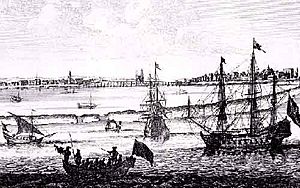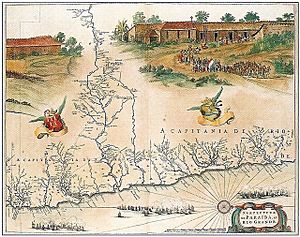Action of 12–17 January 1640 facts for kids
Quick facts for kids Action of 12–17 January 1640 |
|||||||
|---|---|---|---|---|---|---|---|
| Part of Eighty Years' War and Dutch-Portuguese War | |||||||
|
|||||||
| Belligerents | |||||||
| Commanders and leaders | |||||||
| Fernando de Mascarenhas | Willem Loos † | ||||||
| Strength | |||||||
| 30 galleons 34 armed transports 13 small vessels |
30 warships and supply ships 10 small vessels |
||||||
| Casualties and losses | |||||||
| 2 vessels lost | 1 vessel lost | ||||||
The Action of 12–17 January 1640 was an important naval battle. It happened between a Dutch fleet and a combined Spanish-Portuguese fleet. This fight was part of the larger Eighty Years' War and the Dutch-Portuguese War.
The battle took place off the coast of Brazil, near Pernambuco. A large fleet of about 80 ships carried 5,000 soldiers. They were led by Portuguese Admiral Fernando de Mascarenhas. Their goal was to land troops to help the Portuguese army. This army was trying to capture the city of Recife.
On January 12, 1640, a Dutch fleet of about 40 ships met them. This Dutch force was commanded by Willem Loos. The battle started that day and continued with breaks until January 17. In the end, the Spanish and Portuguese fleet had to retreat. They sailed away to the north, giving the Dutch a victory.
Why the Battle Happened
This battle was part of a bigger struggle for control of Brazil. The Dutch Republic and the Portuguese Empire were fighting over valuable sugar-producing lands. Spain and Portugal were united under one king at this time. So, Spain also joined the fight.
In 1635, a Spanish and Portuguese fleet arrived in Dutch Brazil. They brought 2,500 soldiers. These soldiers helped fight against the Dutch. Spain saw this as a success. They then planned another big expedition. This new plan was to take back the Dutch base of Pernambuco.

The command of this new mission was offered to several leaders. Finally, Dom Fernando de Mascarenhas, a former governor, accepted. He was given command of 41 ships. Twenty-three of these ships were Portuguese. The other 18 were Castilian (Spanish). About 5,000 soldiers were on board. Half of them were from a special unit called the Tercio de Anfibios. These soldiers were trained for fighting at sea.
The fleet stopped at the Cape Verde islands. There, a terrible sickness spread among the crews. About 3,000 men died. Many more became too sick to fight. Mascarenhas then spent a year in Salvador da Bahia. He ignored orders to attack Recife right away. In January 1640, he finally set sail. His plan was to land 1,200 soldiers. These soldiers would help the Portuguese fighters around Recife.
The Fight at Sea

A Dutch fleet of 36 ships came out from Recife. They were led by Admiral Willem Corneliszoon Loos. On January 12, they met the Spanish-Portuguese fleet. This happened between Itamaracá and Goiana. The Dutch stopped the enemy before any troops could land.
The battle quickly became a messy fight. Admiral Loos lost two of his ships. He was also killed on his own ship, the Faam. He died while fighting Mascarenhas's flagship. Other Dutch ships tried to help. They pulled his ship away from the Spanish flagship. But the Faam sank, taking the admiral with it. Another Dutch ship, the Alemar, was badly damaged. It could not continue fighting.
Vice Admiral Jacob Huygens took command. He was now on Loos's former ship. The chase continued the next day. The Dutch used their powerful cannons from a distance. Only one Dutch ship, the Soleil Brillant, was lost that day. It was badly damaged and sank with its commander.
On January 14, Huygens attacked again near Paraíba. The Portuguese ship of Captain António da Cunha Andrade was captured. Another Spanish ship ran aground and was boarded by the Dutch. Its crew was taken prisoner. The Dutch ship Zwaan also lost its main mast. It drifted away and ran aground on the coast.
The Spanish-Portuguese fleet had to sail northwest. The Dutch followed them closely. For a few days, there was no wind, so neither fleet could attack. On January 17, the wind finally picked up. The Dutch gained the advantage and attacked. Mascarenhas's ship was damaged. After this, the Dutch stopped chasing them.
The Spanish-Portuguese ships were able to land their soldiers. They landed at Cape São Roque. This was too far away to threaten Recife. Both sides lost ships and men. But the battle is generally seen as a Dutch victory. Some Dutch captains were later punished for not fighting well. Mascarenhas was also arrested when he returned to Spain.
What Happened Next
In March 1640, the Dutch sent more soldiers to Recife. About 2,500 troops arrived on 28 ships. These ships were led by Admirals Cornelis Jol and Jan Lichthart. They were tasked with stopping the Portuguese sugar trade.
In December, Portugal rebelled against Spanish rule. This was called the Portuguese Restoration War. The Duke of Bragança became King João IV of Portugal. The Dutch were happy about this news. They hoped Portugal would become their ally. However, this did not happen. The Dutch did not want to give back the lands they had taken from Portugal.
Recife became a base for new Dutch expeditions. In 1641, Jol and Lichthart sailed from there. They captured Portugal's slave trading posts in Angola. A ten-year truce was signed between the Dutch and Portuguese in Europe. But the fighting continued in Brazil. This eventually led to the Dutch being forced out of Brazil in 1654.

